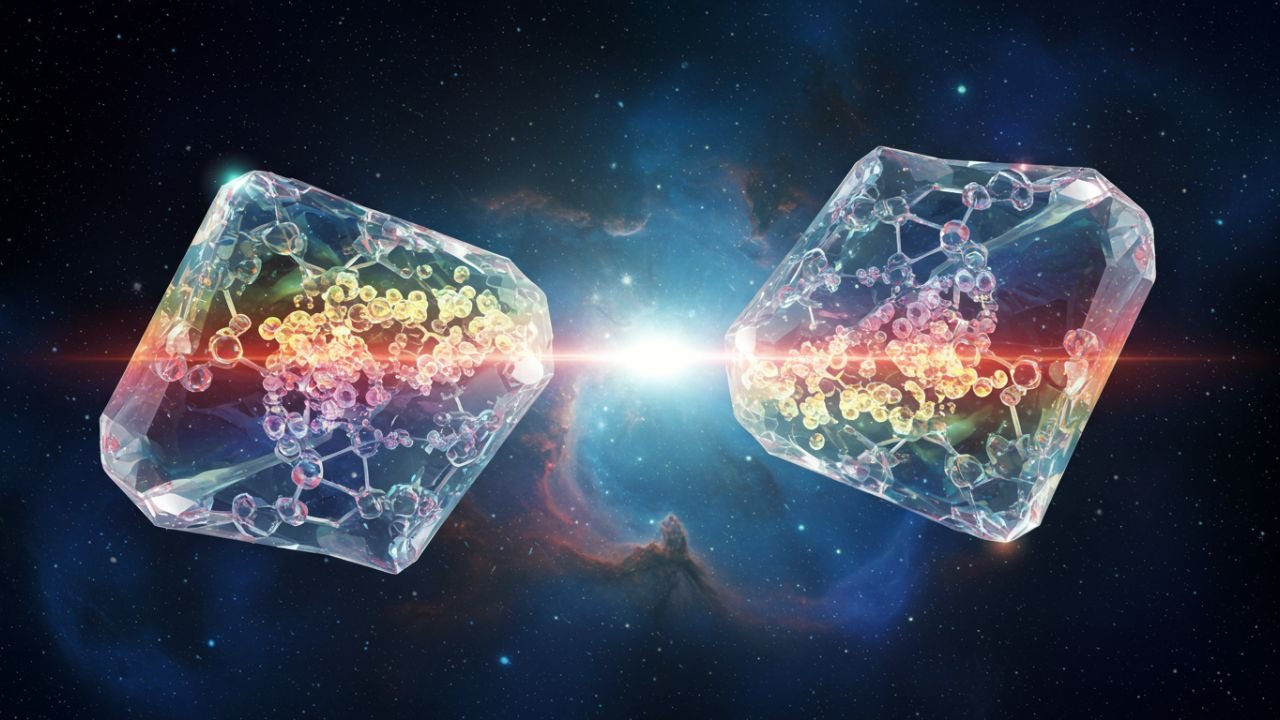Physicists have discovered a new phase called “Time Crystal” by manipulating quantum spins within diamond structures. Quantum spins are a basic feature of tiny particles, like electrons, that act like tiny magnets and affect how they behave in a quantum system. Time crystals are special because they run in repeated patterns without using energy, breaking a basic rule in physics that implies the laws of physics are always the same. This breakthrough is important because it challenges what we know about matter and could lead to big improvements in quantum computing and advanced technology.
Also Read: If time is an illusion, then why do we age?
Scientists created this effect using nitrogen-vacancy (NV) centers using defects in diamonds. By sending precisely timed electromagnetic pulses, they made the atomic spins move in a predictable cycle, even without energy input. This discovery could help build more stable and efficient quantum computers, changing the future of computing and precision measurements.
What are time crystals?

Time Crystals are a special type of matter where particles form repeating patterns, not just in space like regular crystals but also in time, making them “tick” at constant intervals. This breakthrough from Washington University in St. Louis (WashU), led by experts including Kater Murch and Chong Zu, along with collaborators from MIT and Harvard, challenges conventional ideas about time and motion, demonstrating that these particles can exhibit stable, periodic behavior without using energy. As Zu explains, “Just as atoms in a diamond form a repeating pattern in space, the particles in a time crystal repeat a pattern over time,” a discovery published on March 12 in Physical Review X that could pave the way for more stable quantum computers and highly precise measurement tools.
How Are Time Crystals Different from Regular Crystals?

Regular crystals like diamonds, quartz, and ice have atoms arranged in fixed, repeating patterns in space. This stable configuration remains unchanged unless external forces are applied. In contrast, time crystals not only have a repeating pattern but also exhibit a periodic pattern in time. Their atoms move in a rhythmic, clock-like manner even at their lowest energy state, much like a clock that keeps ticking without being wound. This perpetual motion, where the system repeatedly returns to the same configuration, challenges the conventional idea that objects at rest should remain still and marks a fundamentally new phase of matter.
How Were Time Crystals Created?
The first crystal was made at the University of Maryland in 2016, and now the team at Washington University in St. Louis has advanced the field by creating a time quasicrystal, describing it as “an entirely new phase of matter.” They achieved this by precisely manipulating quantum spins in a diamond using tiny defects called nitrogen-vacancy (NV) centers, and by using exactly timed microwave or laser pulses to make the spins move back and forth at a slower rate than the pulses, causing the system to repeatedly return to the same configuration even at its lowest energy state.
🔬 Subscribe to SciMail
Get the latest science discoveries straight to your inbox!
What Makes Them Unique?

Time crystals are a special type of matter that break the usual rules of physics. Unlike most systems, where motion stops at the lowest energy state, time crystals keep moving in a steady, repeating pattern without using energy. Physicist Chong Zu says, “In theory, this could continue indefinitely.” However, they are fragile and react easily to their surroundings, lasting for hundreds of cycles before breaking down.
- They exhibit ongoing movement in a cyclic pattern, even in their lowest energy state.
- Their motion is self-sustaining, akin to a clock that doesn’t require winding or batteries.
- They contradict traditional physics, which asserts that stationary systems should remain still.
- While theoretically perpetual, they ultimately succumb to environmental influences.
- They hold promising prospects for use in quantum computing and precision measurement.
How Are Time Quasicrystals Made?

- Prepare the Quantum Spins: Scientists use a diamond with nitrogen-vacancy (NV) centers, which act like tiny quantum magnets, and initialize the quantum spins into a controlled state.
- Apply Quasi-Periodic Pulses: Instead of regular, periodic pulses, researchers apply microwave or laser pulses in a carefully tuned, quasi-periodic sequence ordered but not exactly repeating.
- Observe Time Quasicrystal Behavior: This pulse sequence causes the spins to evolve in a complex, self-sustaining pattern that never exactly repeats, forming a time quasicrystal, a new and a exotic phase of matter.
What Are Their Applications?
The team built their time quasicrystals inside a small, millimeter-sized diamond by bombarding it with nitrogen beams that knocked out carbon atoms, leaving tiny vacancies filled with electrons that interact at the quantum level. With over a million of these vacancies, each quasicrystal is about one micrometer across and visible only under a microscope. Microwave pulses were then used to initiate a rhythmic pattern in the quasicrystals, creating order in time. These unique structures hold exciting potential for applications such as more reliable qubits for quantum computers and highly sensitive sensors that could enhance navigation, communication, and other technologies relying on precise timing and quantum effects.
What Are the Potential Uses and Future of Time Crystals and Quasicrystals?

Time crystals and quasicrystals offer exciting possibilities across several advanced technologies:
- Quantum Computing: Enables more stable and energy-efficient qubits, improving speed and reliability.
- Precision Sensing: Support highly sensitive sensors and timing devices for better navigation, communication, and medical imaging.
- Data & Energy Systems: Potential for innovations in data storage and energy-efficient technologies.
- Future Technologies: Continued research may unlock even more applications in emerging quantum and computing fields.


Leave a Reply